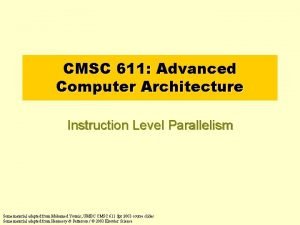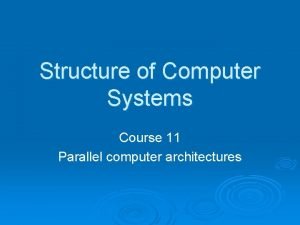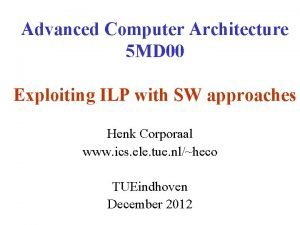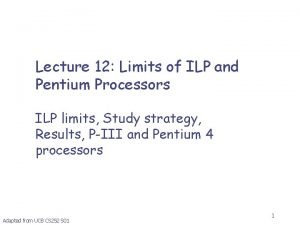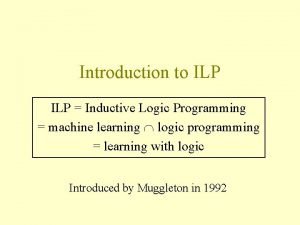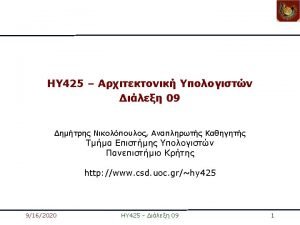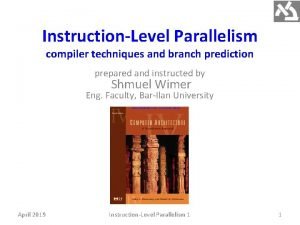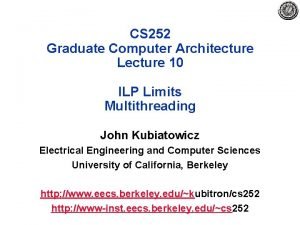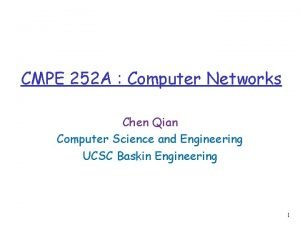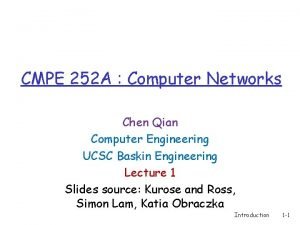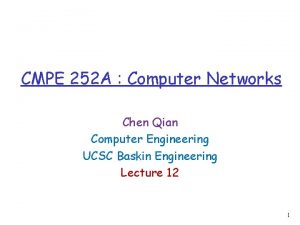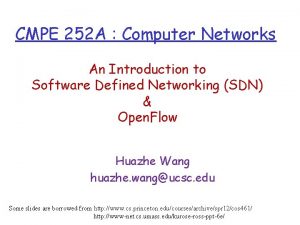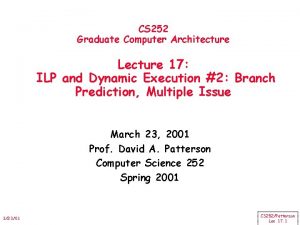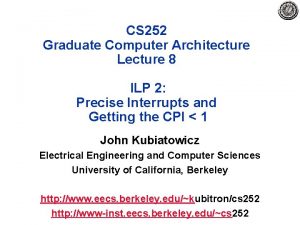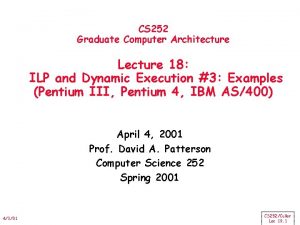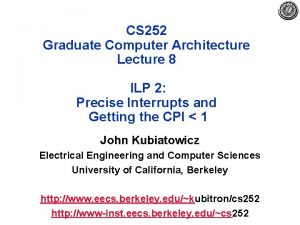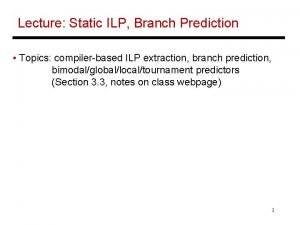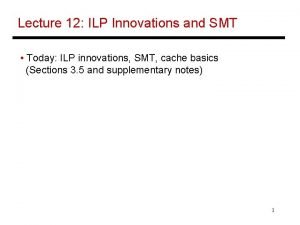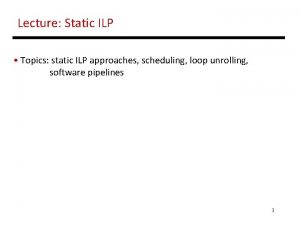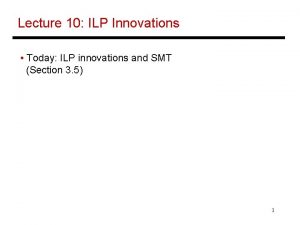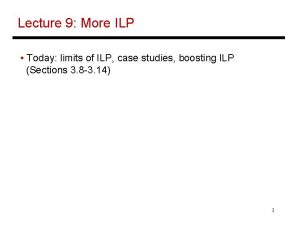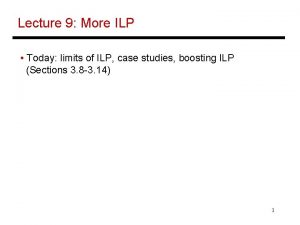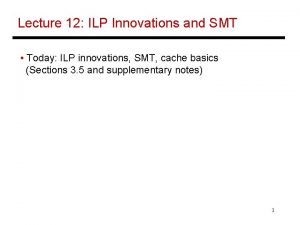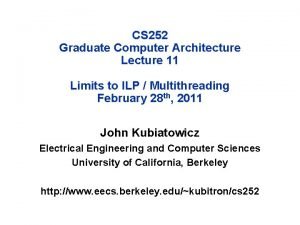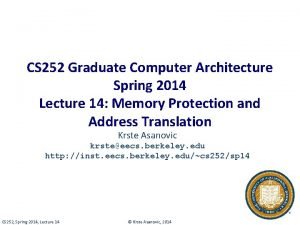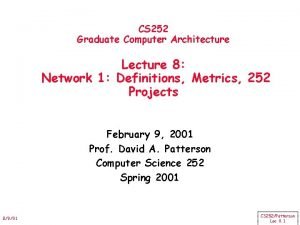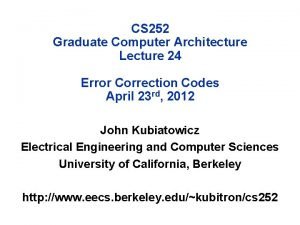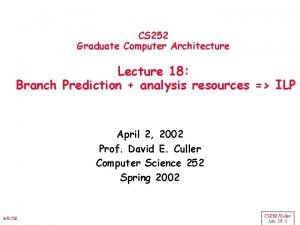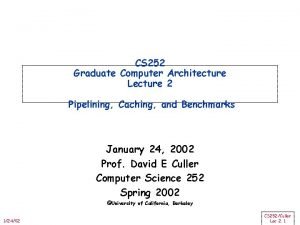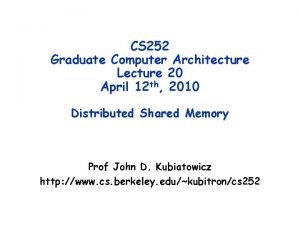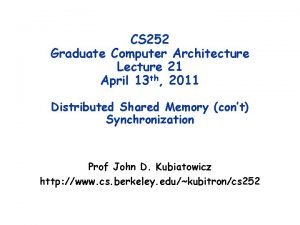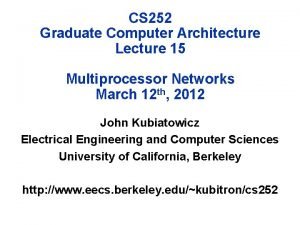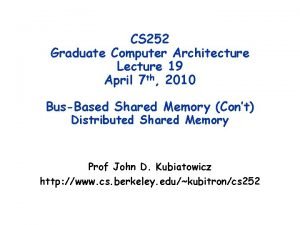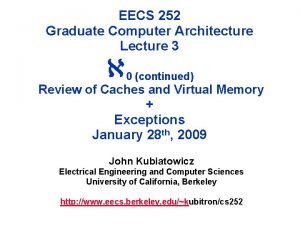CS 252 Graduate Computer Architecture Lecture 18 ILP





























- Slides: 29

CS 252 Graduate Computer Architecture Lecture 18: ILP and Dynamic Execution #3: Examples (Pentium III, Pentium 4, IBM AS/400) April 4, 2001 Prof. David A. Patterson Computer Science 252 Spring 2001 4/4/01 CS 252/Patterson Lec 18. 1

Review: Dynamic Branch Prediction • Prediction becoming important part of scalar execution • Branch History Table: 2 bits for loop accuracy • Correlation: Recently executed branches correlated with next branch. – Either different branches – Or different executions of same branches 4/4/01 • Tournament Predictor: more resources to competitive solutions and pick between them • Branch Target Buffer: include branch address & prediction • Predicated Execution can reduce number of branches, number of mispredicted branches • Return address stack for prediction of indirect jump CS 252/Patterson Lec 18. 2

Review: Limits of ILP • 1985 -2000: 1000 X performance – Moore’s Law transistors/chip => Moore’s Law for Performance/MPU • Hennessy: industry been following a roadmap of ideas known in 1985 to exploit Instruction Level Parallelism to get 1. 55 X/year – Caches, Pipelining, Superscalar, Branch Prediction, Out-of-order execution, … • ILP limits: To make performance progress in future need to have explicit parallelism from programmer vs. implicit parallelism of ILP exploited by compiler, HW? – Otherwise drop to old rate of 1. 3 X per year? – Less because of processor-memory performance gap? • Impact on you: if you care about performance, better think about explicitly parallel algorithms vs. rely on ILP? 4/4/01 CS 252/Patterson Lec 18. 3

Dynamic Scheduling in P 6 (Pentium Pro, III) • Q: How pipeline 1 to 17 byte 80 x 86 instructions? • P 6 doesn’t pipeline 80 x 86 instructions • P 6 decode unit translates the Intel instructions into 72 -bit micro-operations (~ MIPS) • Sends micro-operations to reorder buffer & reservation stations • Many instructions translate to 1 to 4 micro-operations • Complex 80 x 86 instructions are executed by a conventional microprogram (8 K x 72 bits) that issues long sequences of microoperations • 14 clocks in total pipeline (~ 3 state machines) 4/4/01 CS 252/Patterson Lec 18. 4

Dynamic Scheduling in P 6 Parameter 80 x 86 microops Max. instructions issued/clock 3 6 Max. instr. complete exec. /clock 5 Max. instr. commited/clock 3 Window (Instrs in reorder buffer) 40 Number of reservations stations 20 Number of rename registers 40 No. integer functional units (FUs) 2 No. floating point FUs 1 No. SIMD Fl. Pt. FUs 1 No. memory Fus 1 load + 1 store 4/4/01 CS 252/Patterson Lec 18. 5

P 6 Pipeline • 14 clocks in total (~3 state machines) • 8 stages are used for in-order instruction fetch, decode, and issue – Takes 1 clock cycle to determine length of 80 x 86 instructions + 2 more to create the micro-operations (uops) • 3 stages are used for out-of-order execution in one of 5 separate functional units • 3 stages are used for instruction commit Instr Fetch 16 B /clk 4/4/01 16 B Instr 6 uops Decode 3 Instr /clk Reserv. Reorder Execu. Gradu. Station Buffer tion ation Renaming units 3 uops (5) /clk CS 252/Patterson Lec 18. 6

P 6 Block Diagram • IP = PC From: http: //www. digitlife. com/articles/pentium 4/ 4/4/01 CS 252/Patterson Lec 18. 7

Pentium III Die Photo • • • • • 1 st Pentium III, Katmai: 9. 5 M transistors, 12. 3 * 4/4/01 10. 4 mm in 0. 25 -mi. with 5 layers of aluminum EBL/BBL - Bus logic, Front, Back MOB - Memory Order Buffer Packed FPU - MMX Fl. Pt. (SSE) IEU - Integer Execution Unit FAU - Fl. Pt. Arithmetic Unit MIU - Memory Interface Unit DCU - Data Cache Unit PMH - Page Miss Handler DTLB - Data TLB BAC - Branch Address Calculator RAT - Register Alias Table SIMD - Packed Fl. Pt. RS - Reservation Station BTB - Branch Target Buffer IFU - Instruction Fetch Unit (+I$) ID - Instruction Decode ROB - Reorder Buffer MS - Micro-instruction Sequencer CS 252/Patterson Lec 18. 8

P 6 Performance: Stalls at decode stage I$ misses or lack of RS/Reorder buf. entry 4/4/01 CS 252/Patterson Lec 18. 9

P 6 Performance: uops/x 86 instr 200 MHz, 8 KI$/8 KD$/256 KL 2$, 66 MHz bus 4/4/01 CS 252/Patterson Lec 18. 10

P 6 Performance: Branch Mispredict Rate 4/4/01 CS 252/Patterson Lec 18. 11

P 6 Performance: Speculation rate (% instructions issued that do not commit) 4/4/01 CS 252/Patterson Lec 18. 12

P 6 Performance: Cache Misses/1 k instr 4/4/01 CS 252/Patterson Lec 18. 13

P 6 Performance: uops commit/clock Average 0: 55% 1: 13% 2: 8% 3: 23% 4/4/01 Integer 0: 40% 1: 21% 2: 12% 3: 27% CS 252/Patterson Lec 18. 14

P 6 Dynamic Benefit? Sum of parts CPI vs. Actual CPI Ratio of sum of parts vs. actual CPI: 1. 38 X avg. (1. 29 X integer) 4/4/01 CS 252/Patterson Lec 18. 15

Administratrivia • 3 rd (last) Homework on Ch 3 due Saturday • 3 rd project meetings 4/11 • Quiz #2 4/18 310 Soda at 5: 30 4/4/01 CS 252/Patterson Lec 18. 16

AMD Athlon • Similar to P 6 microarchitecture (Pentium III), but more resources • Transistors: PIII 24 M v. Althon 37 M • Die Size: 106 mm 2 v. 117 mm 2 • Power: 30 W v. 76 W • Cache: 16 K/256 K v. 64 K/256 K • Window size: 40 vs. 72 uops • Rename registers: 40 v. 36 int +36 Fl. Pt. • BTB: 512 x 2 v. 4096 x 2 • Pipeline: 10 -12 stages v. 9 -11 stages • Clock rate: 1. 0 GHz v. 1. 2 GHz • Memory bandwidth: 1. 06 GB/s v. 2. 12 GB/s 4/4/01 CS 252/Patterson Lec 18. 17

Pentium 4 • Still translate from 80 x 86 to micro-ops • P 4 has better branch predictor, more FUs • Instruction Cache holds micro-operations vs. 80 x 86 instructions – no decode stages of 80 x 86 on cache hit – called “trace cache” (TC) • Faster memory bus: 400 MHz v. 133 MHz • Caches – Pentium III: L 1 I 16 KB, L 1 D 16 KB, L 2 256 KB – Pentium 4: L 1 I 12 K uops, L 1 D 8 KB, L 2 256 KB – Block size: PIII 32 B v. P 4 128 B; 128 v. 256 bits/clock • Clock rates: – Pentium III 1 GHz v. Pentium IV 1. 5 GHz – 14 stage pipeline vs. 24 stage pipeline 4/4/01 CS 252/Patterson Lec 18. 18

Pentium 4 features • Multimedia instructions 128 bits wide vs. 64 bits wide => 144 new instructions – When used by programs? ? – Faster Floating Point: execute 2 64 -bit Fl. Pt. Per clock – Memory FU: 1 128 -bit load, 1 128 -store /clock to MMX regs • Using RAMBUS DRAM – Bandwidth faster, latency same as SDRAM – Cost 2 X-3 X vs. SDRAM • • 4/4/01 ALUs operate at 2 X clock rate for many ops Pipeline doesn’t stall at this clock rate: uops replay Rename registers: 40 vs. 128; Window: 40 v. 126 BTB: 512 vs. 4096 entries (Intel: 1/3 improvement) CS 252/Patterson Lec 18. 19

Pentium, Pentium Pro, Pentium 4 Pipeline • Pentium (P 5) = 5 stages Pentium Pro, III (P 6) = 10 stages (1 cycle ex) Pentium 4 (Net. Burst) = 20 stages (no decode) From “Pentium 4 (Partially) Previewed, ” Microprocessor Report, 8/28/00 4/4/01 CS 252/Patterson Lec 18. 20

Block Diagram of Pentium 4 Microarchitecture • BTB = Branch Target Buffer (branch predictor) • I-TLB = Instruction TLB, Trace Cache = Instruction cache • RF = Register File; AGU = Address Generation Unit • "Double pumped ALU" means ALU clock rate 2 X => 2 X ALU F. U. s From “Pentium 4 (Partially) Previewed, ” Microprocessor Report, 8/28/00 4/4/01 CS 252/Patterson Lec 18. 21

Pentium 4 Die Photo • 42 M Xtors – PIII: 26 M • 217 mm 2 – PIII: 106 mm 2 • L 1 Execution Cache – Buffer 12, 000 Micro-Ops • 8 KB data cache • 256 KB L 2$ 4/4/01 CS 252/Patterson Lec 18. 22

Benchmarks: Pentium 4 v. PIII v. Althon • SPECbase 2000 – Int, P 4@1. 5 GHz: 524, PIII�@1 GHz: 454, AMD Althon@1. 2 Ghz: ? – FP, P 4@1. 5 GHz: 549, PIII�@1 GHz: 329, AMD Althon@1. 2 Ghz: 304 • World. Bench 2000 benchmark (business) PC World magazine, Nov. 20, 2000 (bigger is better) – P 4 : 164, PIII : 167, AMD Althon: 180 • • Quake 3 Arena: P 4 172, Althon 151 SYSmark 2000 composite: P 4 209, Althon 221 Office productivity: P 4 197, Althon 209 S. F. Chronicle 11/20/00: "… the challenge for AMD now will be to argue that frequency is not the most important thing-- precisely the position Intel has argued while its Pentium III lagged behind the Athlon in clock speed. " 4/4/01 CS 252/Patterson Lec 18. 23

Why? • • Instruction count is the same for x 86 Clock rates: P 4 > Althon > PIII How can P 4 be slower? Time = Instruction count x CPI x 1/Clock rate • Average Clocks Per Instruction (CPI) of P 4 must be worse than Althon, PIII • Will CPI ever get < 1. 0 for real programs? 4/4/01 CS 252/Patterson Lec 18. 24

Another Approach: Mulithreaded Execution for Servers • Thread: process with own instructions and data – thread may be a process part of a parallel program of multiple processes, or it may be an independent program – Each thread has all the state (instructions, data, PC, register state, and so on) necessary to allow it to execute • Multithreading: multiple threads to share the functional units of 1 processor via overlapping – processor must duplicate indepedent state of each thread e. g. , a separate copy of register file and a separate PC – memory shared through the virtual memory mechanisms • Threads execute overlapped, often interleaved – When a thread is stalled, perhaps for a cache miss, another thread can be executed, improving throughput 4/4/01 CS 252/Patterson Lec 18. 25

Multithreaded Example: IBM AS/400 • IBM Power III processor, “ Pulsar” – Power. PC microprocessor that supports 2 IBM product lines: the RS/6000 series and the AS/400 series – Both aimed at commercial servers and focus on throughput in common commercial applications – such applications encounter high cache and TLB miss rates and thus degraded CPI • include a multithreading capability to enhance throughput and make use of the processor during long TLB or cache-miss stall • Pulsar supports 2 threads: little clock rate, silicon impact • Thread switched only on long latency stall 4/4/01 CS 252/Patterson Lec 18. 26

Multithreaded Example: IBM AS/400 • Pulsar: 2 copies of register files & PC • < 10% impact on die size • Added special register for max no. clock cycles between thread switches: – Avoid starvation of other thread 4/4/01 CS 252/Patterson Lec 18. 27

Simultaneous Multithreading (SMT) • Simultaneous multithreading (SMT): insight that dynamically scheduled processor already has many HW mechanisms to support multithreading – large set of virtual registers that can be used to hold the register sets of independent threads (assuming separate renaming tables are kept for each thread) – out-of-order completion allows the threads to execute out of order, and get better utilization of the HW Source: Micrprocessor Report, December 6, 1999 “Compaq Chooses SMT for Alpha” 4/4/01 CS 252/Patterson Lec 18. 28

SMT is coming • Just adding a per thread renaming table and keeping separate PCs – Independent commitment can be supported by logically keeping a separate reorder buffer for each thread • Compaq has announced it for future Alpha microprocessor: 21464 in 2003; others likely On a multiprogramming workload comprising a mixture of SPECint 95 and SPECfp 95 benchmarks, Compaq claims the SMT it simulated achieves a 2. 25 X higher throughput with 4 simultaneous threads than with just 1 thread. For parallel programs, 4 threads 1. 75 X v. 1 4/4/01 Source: Micrprocessor Report, December 6, 1999 “Compaq Chooses SMT for Alpha” CS 252/Patterson Lec 18. 29
 Instruction level parallelism in computer architecture
Instruction level parallelism in computer architecture Ilp in computer architecture
Ilp in computer architecture Ilp computer architecture
Ilp computer architecture Ilp computer architecture
Ilp computer architecture Architecture lecture notes
Architecture lecture notes Isa computer architecture
Isa computer architecture 01:640:244 lecture notes - lecture 15: plat, idah, farad
01:640:244 lecture notes - lecture 15: plat, idah, farad Bus design in computer architecture
Bus design in computer architecture Tvsilp
Tvsilp Pentium 4 block diagram
Pentium 4 block diagram Ilp machine learning
Ilp machine learning Career cruising.com
Career cruising.com Isolierte extremitätenperfusion ilp
Isolierte extremitätenperfusion ilp Ilp
Ilp Ilp
Ilp Compiler techniques for exposing ilp
Compiler techniques for exposing ilp Ilp
Ilp Http //ilp/fp2
Http //ilp/fp2 Ilp/fp/generic
Ilp/fp/generic Difference between organization and architecture
Difference between organization and architecture Basic computer design
Basic computer design Acordada 252/02
Acordada 252/02 Chen qian ucsc
Chen qian ucsc Chen qian ucsc
Chen qian ucsc Cf-252 decay scheme
Cf-252 decay scheme How to simplify square roots
How to simplify square roots History observation palpation special tests
History observation palpation special tests Cmpe 252
Cmpe 252 Cmpe 252
Cmpe 252 Hexadecimal practice
Hexadecimal practice
